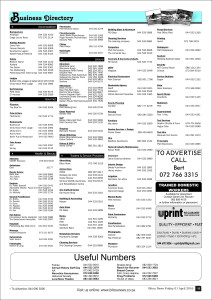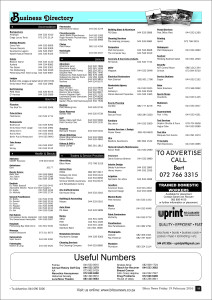Seeff Edition 16
I recently heard from a friend that her son had been arrested for drunk driving and that it had been quite a traumatic experience for the family to get their son released on bail. I have to admit I know nothing about bail and I am worried that I won’t know what to do to help my own child should he or she be arrested one day. How does bail work and what should I know? ”
The reality is that arrest is much more common than one realises, and it doesn’t necessarily only happen to violent criminals. It is therefore important that one knows the basics of how the process works and what has to happen to be released on bail.
Firstly, it is important to be aware of the different types of bail. Our law makes provision for three types, namely police bail, prosecutor’s bail, as well as court bail.
Police bail:
Police bail is usually fixed after hours at the particular police station where the arrested person is detained, and is only possible when a person is accused of a ‘less serious’ charge, for example drunk driving, common assault or store theft.
To have someone released on police bail, it is firstly important to determine where the person is being detained. It will ordinarily be the police station nearest to where the incident took place. Take proof with of where the person lives and works. As soon as you know where the person is detained, you can approach the relevant police officer in command of that station and ask if the person has already been charged. If the person has been charged, the police docket will have a ‘CAS’ number and be allocated to an investigating officer. Ask who the investigating officer is and from him/her if he/she will be willing to fix bail – and if yes, on what basis.
Important to remember is that police bail can only be fixed if a person has a clean criminal record – thus no former offences or pending cases against their name. If police bail cannot be granted, the police may, according to the law, detain a person for 48 hours before the person is brought before court.
Prosecutor’s bail:
Prosecutor’s bail is commonly determined after hours at the particular police station. This type of bail can be fixed for more serious offences, such as for example culpable homicide, assault with the intent to do grievous bodily harm, housebreaking and theft where the alleged stolen goods don’t exceed R20,000. Prosecutor’s bail may not be fixed for offences such as, for example, murder or rape.
The same process that’s followed with police bail, can be followed here. What differs from police bail however, is that a state prosecutor has to be present during the fixing of bail. A list of the state prosecutors and more specifically which prosecutor is on duty, can be obtained at your nearest Magistrate’s Court.
It is important to remember that the investigating officer as well as the prosecutor’s permission is required for this type of bail. The state prosecutor may also link any reasonable conditions to the bail, such as that the accused may not contact the complainant, etc.
Court bail:
Court bail is fixed in court in respect of any other offence. In terms of our law a person has to be brought before court within 48 hours, where the person can then apply for bail. This will be the case where police- or prosecutor’s bail had not been permitted or requested.
The process followed during court bail is complex, given that the court has to take numerous factors into account when deciding whether to grant bail or not. Factors that the court will consider include whether the person has a fixed address, any previous offences and whether the person has any pending cases against him/her.
Important to remember is that the State has the right to postpone any bail application for a period not exceeding seven days, which means the accused will be sent to jail until he can be brought before court again. The State may then again request a postponement for a formal bail hearing. With the congestion in our courts these days it can happen that a bail application only takes place in two weeks’ time. To assist with managing the complex process of court bail, and to prevent a person from having to wait for two weeks for a bail application it’s important to acquire the assistance of a criminal law specialist.
If you are the arrested, it is always wise not to just make a statement. Often one is under intense strain at the time and one’s thoughts are not always clear, in which case it is preferable not to make a statement at that point. It is therefore advisable in all instances of arrest to acquire the assistance of a criminal law specialist that can help manage the legal process best during this taxing times.
HOW TO IMPROVE IN JUST ONE DAY
Every marriage has its ups and downs. There are the days when you look at your spouse and hear choirs humming hallelujahs, and there are the days when you wonder: Who are you, and what is your stuff doing in my house? Those are the days when you play golf. Fishing works, too, or writing sonnets or digging post holes. It keeps the two of you apart for a few hours, and usually that’s all you need.
I have an after-dinner speech about marriage that is about 15 minutes long and somewhat funny. (“The rules for marriage are the same as for a lifeboat. No sudden moves, don’t crowd the other person, and keep all disastrous thoughts to yourself.”) As a thrice-married guy, I feel an obligation to share such insights.
So I found myself in a cab to LaGuardia to catch a plane to Atlanta to give the speech. (I was in New York to speak at the Edith Wharton Society, but not about marriage, since she had a miserable one.) The cab stops at the tollbooth on the Triborough Bridge, and I hand the cabbie a $5 bill for the toll, but he waves it away and gives the man in the booth a $50 bill, which turns out to be counterfeit. “Not just counterfeit,” the toll taker says. “It’s lousy counterfeit.” The $50 bill is confiscated, forms are filled out, I pay the toll, and we get to LaGuardia 30 minutes before flight time. I give the driver $25 for a $23.75 fare, and he yells, “Why take it out on me?” Because you knew the bill was counterfeit – that’s why. I’m no rube. I didn’t just fall off the cabbage wagon.
I dash to the plane. I am speaking at a benefit luncheon, and I dislike benefits because you have to endure other people’s gratitude, which can be exhausting. This sounds ungracious, but it’s true. You go speak for free to a banquet of the Episcopal Promise Keepers of Poughkeepsie or the Honorary Society of Menomonie Economists or the Scandinavian Skin-Diving School in Schenectady, and 30 people tell you what a wonderful thing you’re doing, and it wears you out. If one person would tell you a joke instead, you would throw your arms around him or her in gratitude.
I get on the plane, and I’m in seat 8D on one of those toy jets that airlines have introduced that are designed for groups of fourth graders. The seats are hard on the vertically gifted such as myself, so that when the man in 7D reclines his seat, it almost kills me.
If Abraham Lincoln were sitting in 8D, he would give up on that “malice toward none” concept and club 7D on the top of his little bald head. But I bite my tongue, and I also do not shoot my neighbour in 8C, a piggish fellow in an expensive sweater and tasselled shoes, snarfling his lunch while poring over the Wall Street Journal and poking me with his elbow as he eats. I come from a part of America where people apologise if they poke you and make sure not to do it again. He comes from a part of America where you push your way up to the trough and elbow people out of the way.
The benefit luncheon in Atlanta is not a happy time. It is an organisation of Very Rich People Helping Wretched People Without Having to Be in the Same Room As Them, and it’s full of alpha males of the sort you see strutting around airports with phones clipped to their ears hollering at somebody in Cincinnati and gushy women who tell you they adore your TV show and never miss it on Sunday night, even though it’s radio and it’s on Saturday.
I give my 15-minute speech, which suddenly isn’t amusing at all, and the president of Very Rich People gives me, in gratitude for my generosity, a hideous Lucite plaque, which I deposit in a rubbish bin at the airport, and I fly home to Minnesota, and there is my elegant wife waiting at the curb in her car.
It is good to see her. We’ve been married ten years, and surely we have problems, but at the moment, I cannot think of a single one. We drive through the streets of Saint Paul, and there is no place I would rather be. Misery is the secret of happiness in marriage. Go make yourself miserable, and then come home.
-Readersdigest
10 WAYS TO FIT IN FITNESS

The benefits of regular exercise are unrivaled: Physical activity can help you lose weight and prevent a host of ailments, including heart disease, diabetes, and osteoporosis. Being fit also can help you stay mentally sharp.
While most people know they should exercise, you may not know where to start or how to fit it into a busy schedule. The American College of Sports Medicine (ACSM) and the American Heart Association (AHA) recommend that healthy adults get at least 150 minutes of moderate-intensity aerobic activity spread out over five days a week, or 20 minutes of vigorous-intensity aerobic activity on each of three days a week.
“This is something we recommend to all people,” says Gerald Fletcher, MD, a cardiologist at the Mayo Clinic in Jacksonville, Fla., and a spokesman for the AHA.
An ideal fitness routine also includes resistance or weight training to improve muscle strength and endurance. The ACSM and the AHA recommend that most adults engage in resistance training at least twice a week.
Sometimes the problem isn’t motivation — it’s simply finding the time. But scheduling exercise isn’t as difficult as you might think. Here are 10 ways to get you moving more often:
Be less efficient. People typically try to think of ways to make daily tasks easier. But if we make them harder, we can get more exercise, says Sabrena Merrill, MS, of Lawrence, Kan., a certified personal trainer, group fitness instructor, and spokeswoman for the American Council on Exercise (ACE). “Bring in the groceries from your car one bag at a time so you have to make several trips,” Merrill says. “Put the laundry away a few items at a time, rather than carrying it up in a basket.”
Shun labor-saving devices. Wash the car by hand rather than taking it to the car wash. “It takes about an hour and a half to do a good job, and in the meantime you’ve gotten great exercise,” Merrill says. Use a push mower rather than a riding mower to groom your lawn.
Going somewhere? Take the long way. Walking up or down a few flights of stairs each day can be good for your heart. Avoid elevators and escalators whenever possible. If you ride the bus or subway to work, get off a stop before your office and walk the extra distance. When you go to the mall or the grocery store, park furthest from the entrance, not as close to it as you can, and you’ll get a few extra minutes of walking — one of the best exercises there is, Dr. Fletcher says. “Walking is great because anyone can do it and you don’t need any special equipment other than a properly fitting pair of sneakers.”
Be a morning person. Studies show that people who exercise in the morning are more likely to stick with it. As Merrill explains, “Are you going to feel like exercising at the end of a hard day? Probably not. If you do your workout in the morning, you’re not only more likely to do it, but you’ll also set a positive tone for the day.”
Ink the deal. Whether morning, afternoon, or evening, pick the time that is most convenient for you to exercise and write it down in your daily planner. Keep your exercise routine as you would keep any appointment.
Watch your step. Investing in a good pedometer can help you stay motivated. “If you have a pedometer attached to your waist and you can see how many steps you’ve taken, you’ll see it doesn’t take long to walk 5,000 steps and you will be inspired,” Merrill says. And building up to 10,000 steps a day won’t seem like such a daunting a task.
Hire the right help. While weight training is important, if you don’t know what you’re doing, you run the risk of injuring yourself or not being effective, Merrill says. It’s best to get instructions from a personal trainer at the gym. You also can buy a weight-training DVD and follow along in your living room.
Keep records. Grab a diary or logbook, and every day that you exercise, write down what you did and for how long. Your records will make it easy for you to see what you’ve accomplished and make you more accountable. Blank pages? You’d be ashamed.
Phone a friend. Find someone who likes the same activity that you do — walking in the neighborhood, riding bikes, playing tennis — and make a date to do it together. “Exercising with a friend or in a group can be very motivating,” Fletcher says. “You are likely to walk longer or bike greater distances if you’re talking to a friend along the way. The time will go by faster.” Don’t have a buddy who is available? Grab an MP3 player and listen to your favorite music or an audio book while exercising.
Do what you like. Whatever exercise you choose, be sure it’s one that you enjoy. You’re more likely to stick with it if it’s something you have fun doing rather than something you see as a chore, Fletcher says.
If you can’t fit 30 minutes a day into your schedule, get more exercise simply by being less efficient with your chores and adding a little extra walking distance everywhere you go. However, if you pick an activity you like, finding time for fitness will become effortless and the rewards enormous.
WET LANDS DAY CELEBRATED
WETLANDS DAY CELEBRATED ON FRIDAY, 12 FEBRUARY 2016
In keeping with previous years, Laerskool Touwsranten were invited by Eden District Municipality (Eden DM) to partake in the exciting activities 2016 Wetlands Day had on offer at Ebb and Flow in Wilderness. The day kicked off with pupils being introduced to the theme for Wetlands Day 2016 – “Wetlands Day – For Our Future”.
Mr Vernon Gibbs-Halls, Specialist: Environmental Management, Eden DM,
presented and educated pupils on the importance of Wetlands. In addressing the learners, Gibbs-Halls emphasized that Wetlands are vital for human survival and that it is one of the world’s most productive environments; it is the cradle of
biological diversity that produces the perfect habitat for countless species of
plants and animals to survive in.
Thereafter, pupils were treated to a presentation and demonstration on Water
and Beach Safety by Eden Emergency Services. Learners were taught safety
tips, how rip currents work, what to do and who to call in an event of an
emergency. Undoubtedly, one of the highlights of the day, was the brand new and exciting wildlife show that was presented by the Lunchbox Theatre Group. The creative and dynamic Lunchbox Team used their theatre style presentation to educate and entertain learners through important biodiversity messages.
After breaking into two groups, learners went canoeing under the watchful eye of
Muneer Moses, People & Conservation Officer, SANParks, who assisted and
taught learners the skill of canoeing and water safety. The alternating group was also treated to a Mini South African Scoring Sheet (SASS) exercise that was
carried out by Mr David Papier, Environmental Health Practitioner, Eden DM, who taught the pupils about different types of fish and invertebrates living in the
river and how their numbers can determine the health of a river system. Pupils were taken on a guide with Mr Papier to experience and identify the organisms.The day ended with a delicious lunch, sponsored by Salinas Restaurant, who has been actively involved in committing to social responsibility in Wilderness.The Ebb and Flow area falls under the Garden Route National Park and
constitutes a Ramsar site based on the Ramsar Convention. Under the “three pillars” of the Convention, the Contracting Parties commit to:
1. working towards the wise use of all their wetlands;
2. designate suitable wetlands for the list of Wetlands of International
3. cooperate internationally on transboundary wetlands, shared wetland
Wetlands are indispensable for the countless benefits or “ecosystem services” bthat they provide humanity, ranging from freshwater supply, food and building materials, and biodiversity, to flood control, groundwater recharge, and climate change mitigation.
For further information, contact:
Johan Compion – Municipal Health and Environmental Services
E-mail: jcompion@edendm.co.za or contact number: 044-803 1525 / 082 803
5161
Vernon Gibbs-Halls – Specialist: Environmental Management
E-mail: vernon@edendm.co.za or contact number: 044-803 1529 / 072 670 51089
DOG BULLYING: HOW TO SPOT IT AND WHAT TO DO

When you hear the word “bully,” you probably think of the kid who terrorizes the playground. But, believe it or not, dogs can be bullies, too! Like his human counterpart, the dog doing the bullying isn’t an inherently mean animal. More often than not, he just doesn’t understand how to socialize properly, so he gets too worked up to remember how to play nicely or notice when his playmate doesn’t seem to be having fun. Unlike kids on the playground though, it can sometimes be hard to tell when dogs are being bullied. Here’s an overview on dog bullying and how to put a stop to it.
What Types of Dogs Tend to Be Bullied?
Submissive, gentle-natured dogs are often the target of bullying, regardless of their size. Of course, it’s important to remember that what may look like fighting between two very physical dogs can be a romping good time for the dogs themselves (if they have the same type of personality and play preferences). This is why it’s crucial for you to take your dog’s typical behavior and temperament into account when determining whether or not bullying is taking place.
What Are the Signs That Your Dog May Be the Target of Bullying?
You should be on the lookout for these signs that your dog is scared or not engaging in reciprocal play:
She tucks her tail between her legs.
He yawns or licks his lips.
She hides or tries to avoid other dogs.
He rolls over in a submissive manner.
She barks while backing away from another dog.
He is always the one being chased by another dog — he doesn’t take a turn as the chaser.
She is mounted by another dog repeatedly.
Another dog steals his food, water or toys.
How Can You Help Your Bullied Dog?
One way that you can help your bullied dog overcome this difficult time is to boost her self confidence. According to the American Kennel Club, one of the ways you can do so is to expose her to new animals and people on a regular basis. This type of socialization will allow her to become more comfortable around other dogs. If the dog park is too overwhelming for your canine companion, you can start by organizing doggie playdates with your friend’s well-behaved pets.
What Should You Do When You See Your Dog Being Bullied?
While you may feel the urge to step in as your dog’s protector, it’s important to remember that you should never try to discipline another canine that you meet in the park. Check out Master Dog Park Etiquette for some more tips.
Instead, focus on your own pet. Start by calling him over to you. If you feel like the situation is spinning out of control, you should simply leave the vicinity. And if you find that there are certain canines that never play well with your own, you should just avoid the dog park entirely when you see them there.
What Should You Do if Your Dog Is the Bully?
You may find that — yikes! — your dog is the one doing the bullying. As such, it’s just as important to be aware of what might indicate aggressive behavior in your own pet. If you learn to recognize when your dog is getting overexcited, you’ll be able to calm him down before he acts out.
According to the Atlanta Humane Society, you should watch out for these signs of aggression:
The hair on his back raises.
She crouches.
He growls.
She puts her ears forward and holds her tail rigid, high above her back.
He moves toward another dog slowly.
If you find that your dog is acting like a bully, you can train her to play nicely with others, but this will, of course, take some work on your part. You should start by teaching her a “pay attention” command that will trigger her to come sit in front of you and look at your face.
Work with her on this until she follows the command consistently. Then, when you see your dog starting to get overexcited, you should call her over using this command and then speak to her gently to calm her down. Be sure to give lots of positive reinforcement and treats during this learning process.
-www.care.com







